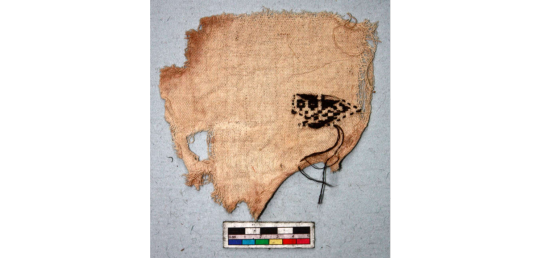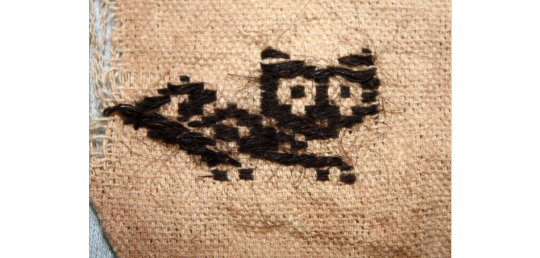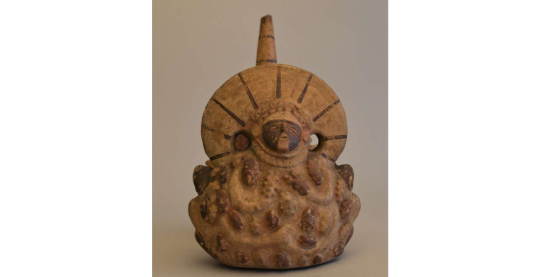#Chimu culture
Text

Silver repousse disc, Chimu culture (Peru), 1100-1400 AD
from The Detroit Institute of Arts
286 notes
·
View notes
Photo



textile
Cultures/periods: Chimu (?) Chancay (?)
Production date: 900-1430
Made in: Peru
Provenience unknown, possibly looted
Textile fragment; cotton plain weave ground with paired warps; camelid supplementary weft patterning; feline figure; cream and black.
British Museum
30K notes
·
View notes
Photo

The Silver of the Conquistadors
The Spanish conquistadors might have gained a lasting reputation as the great gold-seekers of history, but they were actually far more successful in acquiring silver. Over 100 tons of gold were extracted from the Americas from 1492 to 1560, but the quantity of silver ultimately shipped in the treasure fleets back to Spain dwarfed that figure. By 1600, 25,000 tons of silver had been transported to Spain.
The process of acquiring silver had two phases. First, the conquistadors stole whatever they came across of value, kidnapping and torturing anyone they thought had knowledge of the whereabouts of valuables. The second phase was to investigate the source of the metal, that is to find and expand through forced labour the silver mines American rulers had themselves been exploiting. Mines like Potosí in Bolivia proved to be so lucrative that silver soon far outstripped gold as the most valuable cargo of the Spanish treasure fleets that shipped the resources of the Americas to Europe.
Properties & Supply
Silver was esteemed by many ancient cultures because of its relative softness, which made it easy to work by metalsmiths, and the fact that when polished it gains a lustrous shine. Silver was mined in ancient Mesoamerica and South America and was much valued by the Aztecs, Incas, Moche, Wari, Lambayeque, and Chimu cultures, amongst others.
The Spanish conquistadors arrived in the Americas in the final decade of the 15th century, and they were most interested in finding gold since it was much more valuable than silver – 1 oz of gold bought 11 oz of silver in Amsterdam in the 16th century. Silver was a good second prize, though. The early conquistadors plundered whatever artefacts they could of silver and melted them down to create coinage and bullion bars for ease of transport and sharing out between them. Indigenous people were mercilessly robbed, captured, and tortured to find out where their silver and other valuables were hidden. Countless works of art, often of high religious significance to the indigenous peoples, were lost forever in this ruthless quest for cash. When the silver items ran out, the conquistadors turned their attention to the source: the mines. These they found and further exploited while new mines were also located. Eventually, thanks to the massive yields of the silver mines in Mexico and Bolivia, it was silver and not gold that dominated the meticulously kept pages of Spanish colonial accountants. By 1540, silver made up over 85% of annual precious metal shipments to Spain.
Continue reading...
32 notes
·
View notes
Text

Gold bead bracelet, Chimu culture (Peru), 900-1470 AD
from Dumbarton Oaks
234 notes
·
View notes
Text
la real salida 2.0 🤑🤑


things of peruvian culture: chimu, moche, etc
7 notes
·
View notes
Text


☀ cross stitch of a cat , which is about 1000 years old !
A textile fragment was found in Peru. It belongs to the Chimu or Chancay culture (pre-Columbian era X - XV centuries)
13 notes
·
View notes
Text
During the 13th century, Peru experienced a period of widespread conflict and instability, with multiple empires vying for control of the region. Amidst this turmoil, one indigenous Andean group, the Chimu, developed a unique solution to ensure the survival of their people and culture: they built biospheres.
Biospheres, also known as huacas in the Quechuan language, were self-sustaining, enclosed environments that supported the growth of plants and animals. They were essentially miniature ecosystems, created by the Chimu to provide a steady food supply and protect against the harsh conditions of their environment.
One of the main reasons for the development of biospheres in Peru during the 1230s was the recurring droughts and famines that plagued the region. These environmental challenges made it difficult for the Chimu to rely solely on traditional farming methods and forced them to seek alternative solutions.
The construction of biospheres required a significant amount of labor and resources, but the Chimu, known for their advanced engineering skills, were able to create these structures using local materials such as adobe bricks and mud. The domed roofs of the biospheres were made from woven reeds, which were waterproof and allowed for proper air circulation.
Inside these enclosed environments, the Chimu cultivated a variety of plants including corn, beans, and quinoa, as well as raised guinea pigs and llamas for a steady meat supply. The biospheres also provided protection against pests and flooding, helping to ensure a stable food supply for the Chimu people.
Aside from their practical function of providing food and protection, biospheres also held cultural and spiritual significance for the Chimu. Many of these structures were built near important religious sites and were seen as offerings to the gods for protection and abundance.
The use of biospheres spread rapidly among the Andean people during this time, and they became an integral part of the Chimu culture. They were vital for the survival of the community, especially during times of war and social upheaval.
The legacy of the Chimu biospheres can still be seen today in the ruins of their ancient cities, such as Chan Chan. Though the structures may no longer be in use, they serve as a reminder of the innovative methods used by this ancient civilization in adapting to their challenging environment.
In conclusion, the biospheres of Peru in the 1230s were a testament to the resilience and ingenuity of the Chimu people. They not only provided a solution to the practical challenges of their time, but also served as a symbol of their cultural identity and spiritual beliefs.
0 notes
Text
Europe
Hercynia:
Iberia:
Seats of Power: Toledo and the Kingdom of Castille, Abode of Three Faiths
Seats of Power: Santiago de Compostela and the Kingdom of Galicia, Jerusalem of Iberia
Seats of Power: Pamplona, Trifecta of Strife, and Unity
Seats of Power: Oviedo, Raging Embers of Christendom
Nordica:
Italy:
Seats of Power: Venice and the Italian City States, Serenity afloat in Opulence
Balkons:
Seats of Power: Pliska and the First Bulgarian Empire, Contendor of Byzantium
Seats of Power: Preslav and the First Bulgarian Empire, Cradle of Orthodox Slavdom
Seats of Power: Turnovo and Second Bulgarian Empire, The Third Rome
Seats of Power: Constantinople and the Eastern Roman Empire, Crown of the Ecumene
Visegrad:
Seats of Power: Krakow and the Kingdom of Poland, Majesty Ascent in the Plains
Seats of Power: Esztergom and the Kingdom of Hungary, Equestrian Valor imbued with Catholic Glory
Sarmatia:
Seats of Power: Kernave and the Grand Dutchy of Lithuania, Pagan Might of the Balts
Seats of Power: Vilnius and the Grand Dutchy of Lithuania, Mountain of the Iron Wolf
Caucuses:
Seats of Power: Ani and Bagratid Armenia, Where the Angels Nest
Celtic Isles:
Seats of Power: Scone and Medieval Scotland, Throne of Ascension and Sovereignty
Africa
Sahel:
Seats of Power: Timbuktu and the Mali Empire, Mother of Knowledge, Faith, and Wealth
Nile:
Seats of Power: Soba and the Kingdom of Alodia, Verdant Grail of Treasures
Seats of Power: Cairo and the Fatimid Caliphate, Babylon on the Nile
Maghreb:
Seats of Power: Kairouan and Medival North Africa, Mecca of the Magrehb
Guinea:
Seats of Power: Ile Ife and the Medival Yoruba State, Origin of Mankind and All Creation
Swahili Coast:
Seats of Power: Kilwa and the Swahili City States, Merchant Crown of the Coast
Seats of Power: Mogadishu and the Swahili city States, White Pearl of the Indian Ocean
Horn of Africa:
Lake Complex:
South African Plateau:
West Asia:
Arabian Peninsula:
Seats of Power: Medina and the Rashidun Caliphate, Bastion of the Holy Prophet
Levant:
Anatolia:
Iranian Plateau:
Mesopotamia:
Seats of Power: Baghdad and the Abbasid Caliphate, Beating Heart of the Ummah
South Asia:
Indus River Valley:
Ganges River Valley:
Deccan Plateau:
Ghat Coast:
Southeast Asia:
Coastal Lowlands:
Seats of Power: Thang Long and the Dai Viet, Where the Dragon Rises
Seats of Power: Angkor Wat and the Khmer Empire, The Divine Temple City
Shan Plateau:
East Asia:
Tibetan Plateau:
Seats of Power: Lhasa and the Tibetan Empire, Heart of the Supine Demoness
Korean Peninsula:
Manchuria:
Japanese Archipelago:
Seats of Power: Kyoto and Medieval Japan, Tranquility adorned in Flora
Coastal River Basin:
Seats of Power: Chang'an and the Tang Dynasty, City of One Hundred and One Cities
Central Asia:
East Asian Steppe:
Seats of Power: Otuken/Ordubalik and the Gokturk Khaganate, Where All Power and Authority Derives
Shangjing/Lihuangfu: Imperial Splendor of the Half Barbarians
Desert Basin Complex:
Seats of Power: Loulan and the Tocharian Cities, Golden Silk Oasis
Seats of Power: Qocho
Central Asian Mountain Complex:
Turan Basin:
Seats of Power: Merv and the Medival MiddleEast, Rendezvous of Great and Small
North America:
Northeast Woodlands:
Seats of Power: Cahokia and the Mississippian Culture, Spiritual Nucleus of the Great River
Central America:
Seats of Power: Tenochtitlan and the Aztec Empire, Prickled Crown Sprout from Blood
South America:
Andes:
Seats of Power: Chan Chan, Solar Glory of the Chimu
0 notes
Text

Precolumbian Gold Chimu Culture, 1000-1400AD TUMI ceremonial knife depicting legendary chief Naym Lap, gold and turquoise in Museo del Oro, Lima, Peru
0 notes
Text
Finished my first attempt at embroidery. Based on a Chimú pattern obtained from the embedded post. It's here if you wan to try it yourself. It has the right amount of compleximity for me to want to try embroidering and not give up on it.

1 note
·
View note
Text

Silver ornament, Chimu culture, Peru, circa 1100 - 1440
from The Dallas Museum of Art
371 notes
·
View notes
Text



vase; vessel; whistle
Cultures/periods: Chimu
Production date: 1000-1476
Found: Pacasmayo
Provenience unknown, possibly looted
Double- body and bridge vessel with painting in red, dark brown on cream. One of the bodies represent a Spondylus bivalve shell while the other display the image of a deity with crescent headdress and a body covered with bean-like elements.
British Museum
76 notes
·
View notes
Photo

Chimu Civilization
The Chimu civilization, otherwise called the kingdom of Chimor, flourished on the northern coast of Peru between the 12th and 15th centuries CE. With their capital at Chan Chan, the Chimu were the largest and most prosperous culture in the Late Intermediate Period and forged the second-largest empire in the history of the ancient Andes. Their architecture, approach to regional governance, and art would also go on to influence their more famous successors, the Incas.
Learn more about Chimu Civilization
88 notes
·
View notes
Text
Há Museus em Todos os Lugares: Carnaval
No segundo post da série "Há Museus em Todos os Lugares", vamos falar de Carnaval. Os museus estiveram presentes como tema de enredo de escola de samba mais de uma vez.
Em 2018, a Imperatriz Leopoldinense trouxe em seu samba enredo uma homenagem ao bicentenário do Museu Nacional.
youtube
Samba-Enredo 2018 - Uma Noite Real No Museu Nacional
Gira a coroa da majestade
Samba de verdade, identidade cultural
Imperatriz é o relicário
No bicentenário do Museu Nacional
Gira a coroa da majestade
Samba de verdade, identidade cultural
Imperatriz é o relicário
No bicentenário do Museu Nacional
Onde a musa inspira a poesia
A cultura irradia o cantar da Imperatriz
É um palácio, emoldura a beleza
Abrigou a realeza, patrimônio é raiz
Que germinou e floresceu lá na colina
A obra-prima viu o meu Brasil nascer
No anoitecer dizem que tudo ganha vida
Paisagem colorida, deslumbrante de viver
Bailam meteoros e planetas
Dinossauros, borboletas
Brilham os cristais
O canto da cigarra em sintonia
Relembrou aqueles dias que não voltarão jamais
Voa tiê, tucano, arara
Quero-quero ver onça pintada
Os tambores ressoaram, era um ritual de fé
Para o rei de Daomé, para o rei de Daomé
Voa tiê, tucano, arara
Quero-quero ver onça pintada
Os tambores ressoaram, era um ritual de fé
Para o rei de Daomé, para o rei de Daomé
A brisa me levou para o Egito
Onde um solfejo lindo da cantora de Amon
Ecoa sob a Lua e o sereno
Perfumando a deusa Vênus sem jamais sair do tom
Marajó, Carajá, Bororó
Em cada canto, um herdeiro de Luzia
Flautas de chimus e incas
Sopram pelas grimpas, linda melodia
A luz dourada do amanhecer
As princesas deixam o jardim
Os portões se abrem pro lazer
Pipas ganham ares, encontros populares
Decretam que a Quinta é pra você
Gira a coroa da majestade
Samba de verdade, identidade cultural
Imperatriz é o relicário
No bicentenário do Museu Nacional
Gira a coroa da majestade
Samba de verdade, identidade cultural
Imperatriz é o relicário
No bicentenário do Museu Nacional






No mesmo ano, o tema do enredo da Acadêmicos do Tucuruvi foi "Uma Noite no Museu".
Samba-Enredo 2018 - Uma Noite No Museu
Uma noite no museu você e eu
Fazendo história nesse carnaval
É show na galeria, meu Tucuruvi
Pode aplaudir
Sentindo acelerar o coração
A emoção me guia
Desbravando as civilizações
Somos todos guardiões de Alexandria
Faz renascer
De belas artes a inspiração
A genialidade feita a mão
Da Grécia à modernidade
Lá onde o passado eternizou
Só a ciência revelou
Na luz a explosão (boom)
Assim surgiu a vida essência natural
É a vida na pré-história encontrei
Nessa magia me encantei
Em nome do pai
Tempos sombrios, santa inquisição
Dá calafrio ver assombração
Na era da mitologia
É festa na aldeia à luz do luar
Na ginga tem ilusão no olhar
Madame de cera, a cópia fiel
No futebol eterna paixão
O folclore é tradição
Sou eu imagem do som e beleza
Salve a língua portuguesa
Meu samba é Brasil




1 note
·
View note
Note
1975?
1975: time travel!
This is under the no butterfly effect assumption and that I will not affect history in any way, shape, or form. Also I’m assuming that this is just a visit to learn stuff because I don’t actually want to stuck there for an extended period of time. I’m a big fan of modern medicine. I’m also assuming I’ll speak the languages.
I would love to know more of the time they were painting the Lascaux caves and the context around it and other painted caves.
Also the Scythians, knowing more about that culture.
The height of the Minoans at Knossos.
Stonehenge and the reason for its construction. Same with the Uffington Horse.
This is a dark one but knowing the lead up to the mass child sacrifices in Peru by the Chimu people. Archaeologists are confident it was to stop the rain but to be a fly on the wall when those decisions were made. I’d definitely want to leave before it started. (Yes in an ideal situation I would save the kids but I already put the no butterfly effect rule into place. Plus I don’t think a random white woman showing up would change their minds about the god’s control over the weather.)
Eleusinian Mysteries I don’t particularly want to take part because part of it may be an LSD orgy and I’m not comfortable with that. But again, I just wanna know all the facts.
Literally any prehistoric time where we don’t have writing or oral history and have to make guesses based on archaeological evidence. Just to know the truth would be amazing. I just want to know all the things.
I put a lot of thought into this one. 😬. I loved the question Nony!! 🙂
1 note
·
View note
Photo

5 notes
·
View notes